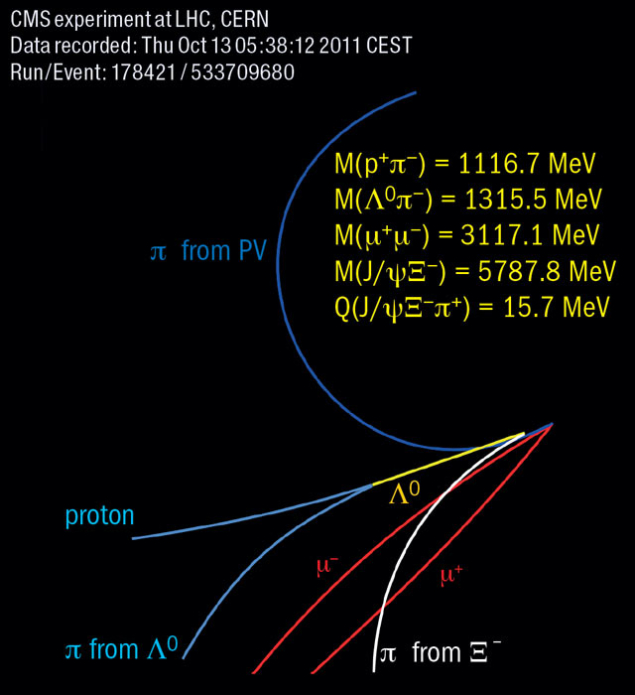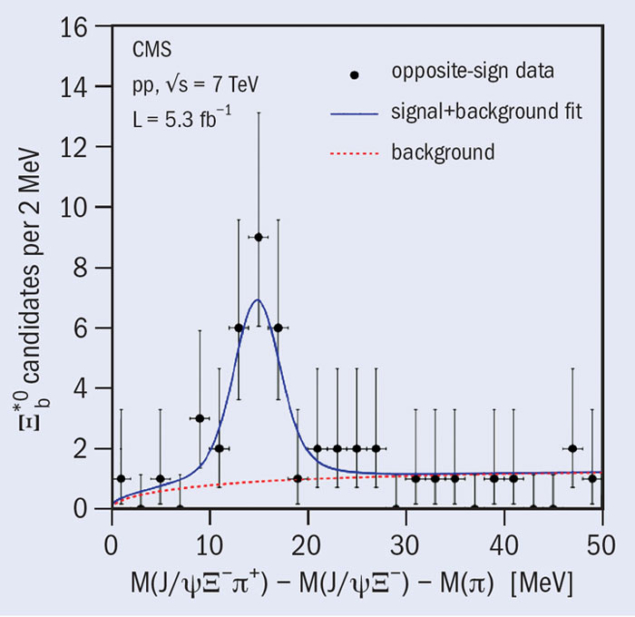
The CMS experiment has discovered its first new particle. The new state is observed with a significance exceeding 5 σ and a mass of 5945.0 ± 2.8 MeV. This mass and the observed decay mode are consistent with its being the beauty-strange baryon known as Ξb*0.
Understanding the detailed spectroscopy of the various families of hadrons has been a quest of scientists ever since quarks were recognized as being the building blocks of protons, neutrons and other hadrons. Baryons are composed of three quarks and if they contain a beauty (b) quark and a strange (s) quark then they are members of the Ξb family. Depending on whether the third valence quark is a u or a d, the resulting baryon is either the neutral Ξb0 or the charged Ξb–. While the charged and neutral lowest-mass states were already known, none of the heavier states had so far been seen. The newly discovered particle is probably the Ξb*0, with a total angular momentum and parity, JP = 3/2+. Its observation helps in understanding how quarks bind and in further validating the theory of strong interactions.
The observation was made in a data sample of 5.3 fb–1 proton–proton collisions at a centre-of-mass energy of 7 TeV, delivered by the LHC in 2011. Figure 1 shows a typical event, where a candidate Ξb*0 (also appropriately called the “cascade b baryon”) leads to a cascade of decays, Ξb*0 → Ξb–π+, Ξb– → J/ΨΞ–, J/Ψ → μ+μ–, Ξ– → Λ0π– and Λ0 → pπ–, ending in one proton, two muons, and three pions. The existence of the Ξb*0 is established by detecting all of these particles and measuring the charge, momentum and point of origin (the vertex) for each one. Requiring that the secondary decay vertices be displaced from the primary vertex reduces the background caused by random combinations of uncorrelated particles, which are copiously produced in high-energy proton–proton collisions.

The invariant-mass distribution of the J/ΨΞ– pairs shows a clear peak corresponding to the Ξb– signal, with a mass in good agreement with the world average. The Ξb*0 is expected to decay promptly to Ξb–π+ pairs, so candidates were sought by combining the reconstructed Ξb– with a track (assumed to be a pion) coming from the primary vertex. To cancel measurement errors partially and so increase the sensitivity, the analysis looked at the mass difference Q = M(J/ΨΞ–π+) – M(J/ΨΞ–) – M(π). Figure 2 shows the mass difference for 21 events in the range 12 < Q < 18 MeV, which clearly exceed the 3.0 ± 1.4 events expected in the absence of a new particle.
The detection of this new particle was possible thanks only to the excellent tracking and vertexing capabilities of the CMS experiment, combined with high-purity dimuon triggers that identify decays of the J/Ψ meson “on the fly”, before storing the events. This measurement shows that CMS can unravel complicated chains of particle decays and bodes well for future discoveries of rare particles.
Further reading
CMS collaboration 2012 arXiv:1204.5955v1








